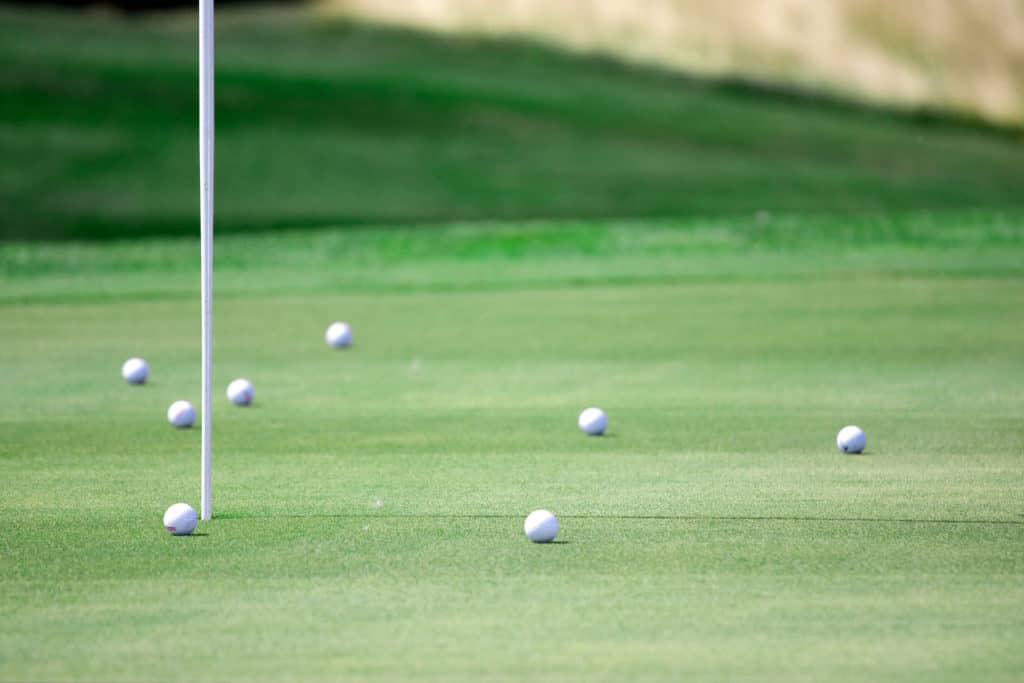Golf can be the most amazing game and at the same time the most frustrating game. Picture this, you have hit your best drive of your round on a short par 4 and are left with a 30 yard pitch shot.
Your opponent is in the trees and all you have to do is hit within 3 feet and you have an easy birdie.
You stand over the ball and a million thoughts run through your head:
- Don’t chunk it.
- Don’t skull it.
- Don’t hit it too far.
- Don’t hit it too short.
- I hope that I hit it close.
- If I can hit it close, I am going to make birdie.
Sound familiar? We have all been there. Sometimes these short shots like the 30 yard pitch shot can be the most difficult in the game. Why? Because it takes a bit of precision and we are trying to be too perfect.
When we stand in the fairway from 150 yards, most amateurs are happy with something on the green. Even the pros might only hit it within 20 feet of the pin.
So we try really hard on these 30 yard pitch shots, we tense up, get in our own mind and as you have experienced, we don’t hit the shot that we need to hit.

How To Hit a 30 Yard Pitch Shot?
The 30 yard pitch shot can drive us crazy in the game, but there can be a simple way to hit the shot. Here is the formula we have experienced to hit the shot that is acceptable and puts us in a good position to make the next putt:
- Assess the complete situation (lie, amount of green to work with, course conditions)
- Select the right shot to increase your chances of a quality shot (3 options)
- Select the right club to match the optimum shot.
- Take some practice swings to assess how the club goes through the grass.
- Build your confidence and vision.
Below we will breakdown each of these 5 key pieces in the formula to hit a quality shot when faced with the 30 yard pitch shot. With enough practice, you will be on your way.
Stick around to the end where we provide you with 3 Bonus Short Game drills/games you can practice or play to make sure you are ready for your next round of golf!
1 – Assess the Complete Situation
The greatest golfers of all time have the ability to read the lie and hit the shot that it calls for. Another major factor that comes into play with this equation is how much green the golfer has to work with.
The amount of green plays a significant role in the club you might select and the shot you will hit.
Here is a quick checklist to utilize:
- What lie do I have? Thick rough, thin fairway, is there grass right behind the ball?
- How much green is there to work with? How far do I want to fly the ball?
- Are the greens firm and fast, or soft and slow?
- Are there bunkers or other hazards that I must carry?
- How much break is there in the green and where do I need to aim?
Once you go through and have an idea it is now time to pick the shot that you will attempt to execute.

2 – Select the Right Shot To Increase your Chance of a Quality Shot
There are three different chip shots that are pretty common. Here is a quick list:
- The hinge and hold where you play the ball more in the back of the stance and de-loft the club through impact. The shot will fly low and come out hot.
- The standard pitch shot where you take the club back and through while maintaining the standard loft on the club for the most part. Depending on the amount of green to work with, can impact the club that you select. Some golfers will fly the ball further and swing further with a 60 degree wedge, while others might opt for the pitching wedge depending on the amount of green to work with.
- The flop shot. This shot flies high and lands soft. This shot might be utilized when there is a sand trap close to the edge of the green and you have a tucked pin. This shot can be played out of thick rough or tightly mowed fairway. It typically carries a high risk, but high reward.
As a golfer, you should know your skillset and pick the shot that you are comfortable with keeping your overall goals in line. If you are down a shot on the 17th or 18th hole and need to save a par, then the flop shot might be your only option.
However, if it’s early in the round and you are just getting going, you might hit the ball 15-20 feet past the hole with a safer shot and hope you can run a putt in the hole.
Quick Tip
Practice all three of these shots on a regular basis. The more shots you have your bag and the more you practice the better your scores will be.
3 – Select the Right Club To Match the Optimum Shot
Now that you have assessed the situation, selected the shot you want to hit, you need to select the right club to execute the shot. Personally, I prefer to hit the majority of my chip and pitch shots with a 60 degree lob wedge.
I will on occasion use an 8, 9 or pw for a bump and run, but I prefer to add loft or de-loft depending on the shot called for. I believe that over time, I can practice enough with my 60 degree club and become most comfortable with utilizing one club for the majority of my short game shots.
I can play a low scooting shot with a 60 degree wedge or hit the high flop shot by adjusting my ball position, hand position and release of the club. Selecting the right club for the shot is important.
If you are trying to hit a flop show with a 48 degree club, you really don’t have a chance due to the bounce on the club and the lack of loft. You must match up the shot you are hitting with the right club or always stick with the highest lofted club that you have in your bag.
I would recommend trying two different approaches. The first one where you change the club and keep a similar swing and the second one to always use your 56 or 60 degree wedge and alter your swing. Here is a way to test it out.
Testing the Options – How to test these two approaches:
- Step 1: Practice for 30-45 minutes with a variety of shots.
- Step 2: Take 10 balls from a variety of spots and see how many times you can chip a ball within 6 feet, but you can only use your 60 degree wedge.
- Step 3: Take 10 balls from a variety of spots and see how many times you can chip a ball within 6 feet, but you should vary your clubs this time.
- Step 4: Repeat steps 2 and 3 until you have a data set of 30 chip shots.
- Step 5: Review the data and your comfort level with both approaches and help this guide you in your decision making process.
- Special Note: You might want to do this over several sessions where you can have data on 100-200 shots and frequently test to see how you feel. You also want to take into consideration your “bad” shots. Were the bad shots much worse with one approach over the other?
Quick Tip
Over time, when you arrive at your next shot, you will quickly understand what is the highest percentage shot to give yourself a chance to save par. You will also become most comfortable with one shot and sometimes being comfortable is an important part of the equation. Don’t force a shot!

4 – Take Some Practice Swings to Assess How the Club Goes Through the Grass
Now that you have assessed the situation, selected the shot, matched the club to the shot, you need to test the grass. Get a feel for where your club is bottoming out and find some grass that looks similar to your lie.
Become comfortable and obtain the feel that you want to use for that shot. If you attend a PGA Tour event you will see the professionals take very limited swings on their full shots, but when they come to a difficult chip or pitch, they will take 3-5 practice swings as they assess how the club is moving through the grass.
This can help train your system for the shot you are going to hit.
Get a good look at your landing spot and the hole and get ready to hit a great shot!
5 – Build Your Confidence and Vision
Confidence comes from practice that is quality and produces good shots. There are so many ways to practice the short game. Just about every practice green in America is free to use and typically pretty empty.
You can spend hours around a practice green for free and never really get tired and your scores will be better. Yet, people pound driver after driver on the driving thinking they are going to find a secret. Remember, 65% of your shots are going to come within 100 yards in your typical round of golf.
By practicing your will start to build the confidence needed on the golf course and the vision for the shot that you can hit. Over time, you will see the shot before you even hit and then be able to step up and execute.
Stop those bad thoughts and instead focus on the task at hand, be confident, step up and hit the shot.
The best way to build this confidence and the vision is to parlay competitive games on the practice green. You can compete against your scores or find a friend to compete with. Either way, build up the pressure and find a way to get better!
One of the best things that ever happened to be me is that we didn’t have a driving range at my home course as a kid. Instead, my buddies and I spend hours around the practicing green, learning to hit just about every chip and pitch shot you would ever face.
The end result…we could all shoot in the 70s at a young age. Not because we hit the ball super long, but because we should get up and down from anywhere on the course to save par. You too can get to that level with the right practice!
Here are three games you can play!
BONUS: 3 Practice Games/Drills to Utilize to Get Better
Game 1:
A great short game practice drill you can compete against yourself with or a friend is to take one ball and see how many times out of 20 you can get up and down to save your par. Throw the ball to a random spot, hit the chip shot and make the putt. Do this for at least 2 rounds and record your score. Track this over the course of time. If you want to reach your full potential and get better fast, the short game is the real secret. Get started today!
Game 2:
Pick three targets on the green, a short, middle and long target. Take three balls and see if you can get each shot to within three feet of the target. This will help you with distance control and not allow you to get in a grove where you are hitting the same distance every time. While there is some merit with ingraining certain feels around the green, when you get out on the course, you only get one chance to hit that shot. Make it count! See how many times in a row you can do this!
Game 3:
Take three balls and chip to one hole, take your worse chip and see if you can make the putt. Count how many times out of ten you can do this. If you can make somewhere close to 3 out of 10 you are really doing well. This makes you focus for three shots in a row and then make a putt. Compete against yourself and don’t forget to log your scores so you can monitor your progress over time.
Here are 22 other games you mind find helpful in your journey to play your best golf yet!
Short game not your thing? Want to gain speed and add 20-40 yards. Check out one of these two quality options:
Final Thoughts
Golf is a wonderful game. The game is much more fun when you are making pars. The short game is the secret to quick success and sustained success. The best golfers you will find have quality short games and can save pars at least 50% of the time.
There will be some rounds when you are feeling it and can save parts close to 80-100% of the time. It doesn’t take great strength, speed or technique to be a short game expert.
Instead, it takes some feel and practice and then confidence when you get over the ball. All three are built through practice and competing and putting in the repetitions to get to that expert level. It can be done!
Take Action – What You Can Do Today to Get Better
What does this mean for you? I believe in the following recipe to get better:
1 – Improve your motion in the golf swing by identifying a golf instructor. Here are some options:
Here is a list of golf instructors that we have reviewed:
2 – Train to swing faster and improve your swing speed. Here are some options:
Looking to gain more Speed and Distance in your swing. Two Options:
3 – Understand course strategy and work to break through your next barrier. Here is a series on breaking through:
We have provided guides on how to break 100, 90, 80 and 70. Check out more below, if interested.
4 – Practice Frequently
Did you know that I build a golf simulator in my garage and have played over 500 rounds of golf on my SkyTrak system? It has been a game changer and one worth checking out. Here are some of my other posts on golf simulators frequently asked questions:
- Is a Golf Simulator Worth It?
- How to Build a Golf Simulator?
- What is the Best Golf Simulator?
- Golf Simulator Accessories?
- How to Build a Golf Simulator for under $7000
- Top 11 Reasons to Buy a SkyTrak
- How to Build a Golf Simulator for Under $1000
- Why Build A Golf Simulator?
- What Space is Needed?
- Can A Golf Simulator Improve My Game?
- How Much Does A Golf Simulator Cost?
- Don’t Forget to Check out our 15 best golf swings of all time.

